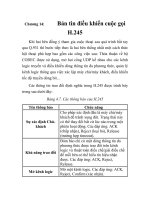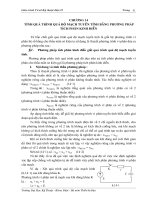Seventh Edition - Chương 14 ppt
Bạn đang xem bản rút gọn của tài liệu. Xem và tải ngay bản đầy đủ của tài liệu tại đây (2.2 MB, 146 trang )
Slide 14.1
© The McGraw-Hill Companies, 2007
Object-Oriented and
Classical Software
Engineering
Seventh Edition, WCB/McGraw-Hill, 2007
Stephen R. Schach
Slide 14.2
© The McGraw-Hill Companies, 2007
CHAPTER 14
IMPLEMENTATION
Slide 14.3
© The McGraw-Hill Companies, 2007
Overview
Choice of programming language
Fourth generation languages
Good programming practice
Coding standards
Code reuse
Integration
The implementation workflow
The implementation workflow: The MSG
Foundation case study
The test workflow: Implementation
Slide 14.4
© The McGraw-Hill Companies, 2007
Overview (contd)
Test case selection
Black-box unit-testing techniques
Black-box test cases: The MSG Foundation case
study
Glass-box unit-testing technique
Code walkthroughs and inspections
Comparison of unit-testing techniques
Cleanroom
Potential problems when testing objects
Management aspects of unit testing
Slide 14.5
© The McGraw-Hill Companies, 2007
Overview (contd)
When to rewrite rather than debug a module
Integration testing
Product testing
Acceptance testing
The test workflow: The MSG Foundation case
study
CASE tools for implementation
Metrics for the implementation workflow
Challenges of the implementation workflow
Slide 14.6
© The McGraw-Hill Companies, 2007
Implementation
Real-life products are generally too large to be
implemented by a single programmer
This chapter therefore deals with programming-in-
the-many
Slide 14.7
© The McGraw-Hill Companies, 2007
14.1 Choice of Programming Language (contd)
The language is usually specified in the contract
But what if the contract specifies that
The product is to be implemented in the “most suitable”
programming language
What language should be chosen?
Slide 14.8
© The McGraw-Hill Companies, 2007
Choice of Programming Language (contd)
Example
QQQ Corporation has been writing COBOL programs
for over 25 years
Over 200 software staff, all with COBOL expertise
What is “the most suitable” programming language?
Obviously COBOL
Slide 14.9
© The McGraw-Hill Companies, 2007
Choice of Programming Language (contd)
What happens when new language (C++, say) is
introduced
C++ professionals must be hired
Existing COBOL professionals must be retrained
Future products are written in C++
Existing COBOL products must be maintained
There are two classes of programmers
COBOL maintainers (despised)
C++ developers (paid more)
Expensive software, and the hardware to run it, are
needed
100s of person-years of expertise with COBOL are
wasted
Slide 14.10
© The McGraw-Hill Companies, 2007
Choice of Programming Language (contd)
The only possible conclusion
COBOL is the “most suitable” programming language
And yet, the “most suitable” language for the latest
project may be C++
COBOL is suitable for only data processing applications
How to choose a programming language
Cost–benefit analysis
Compute costs and benefits of all relevant languages
Slide 14.11
© The McGraw-Hill Companies, 2007
Choice of Programming Language (contd)
Which is the most appropriate object-oriented
language?
C++ is (unfortunately) C-like
Thus, every classical C program is automatically a C++
program
Java enforces the object-oriented paradigm
Training in the object-oriented paradigm is essential
before adopting any object-oriented language
What about choosing a fourth generation language
(4GL)?
Slide 14.12
© The McGraw-Hill Companies, 2007
14.2 Fourth Generation Languages
First generation languages
Machine languages
Second generation languages
Assemblers
Third generation languages
High-level languages (COBOL, FORTRAN, C++, Java)
Slide 14.13
© The McGraw-Hill Companies, 2007
Fourth Generation Languages (contd)
Fourth generation languages (4GLs)
One 3GL statement is equivalent to 5–10 assembler
statements
Each 4GL statement was intended to be equivalent to
30 or even 50 assembler statements
Slide 14.14
© The McGraw-Hill Companies, 2007
Fourth Generation Languages (contd)
It was hoped that 4GLs would
Speed up application-building
Result in applications that are easy to build and quick to
change
Reducing maintenance costs
Simplify debugging
Make languages user friendly
Leading to end-user programming
Achievable if 4GL is a user friendly, very high-level
language
Slide 14.15
© The McGraw-Hill Companies, 2007
Fourth Generation Languages (contd)
Example
See Just in Case You Wanted to Know Box 14.2
The power of a nonprocedural language, and the
price
Slide 14.16
© The McGraw-Hill Companies, 2007
Productivity Increases with a 4GL?
The picture is not uniformly rosy
Playtex used ADF, obtained an 80 to 1 productivity
increase over COBOL
However, Playtex then used COBOL for later
applications
4GL productivity increases of 10 to 1 over COBOL
have been reported
However, there are plenty of reports of bad experiences
Slide 14.17
© The McGraw-Hill Companies, 2007
Actual Experiences with 4GLs
Many 4GLs are supported by powerful CASE
environments
This is a problem for organizations at CMM level 1 or 2
Some reported 4GL failures are due to the underlying
CASE environment
Slide 14.18
© The McGraw-Hill Companies, 2007
Actual Experiences with 4GLs (contd)
Attitudes of 43 organizations to 4GLs
Use of 4GL reduced users’ frustrations
Quicker response from DP department
4GLs are slow and inefficient, on average
Overall, 28 organizations using 4GL for over 3 years felt
that the benefits outweighed the costs
Slide 14.19
© The McGraw-Hill Companies, 2007
Fourth Generation Languages (contd)
Market share
No one 4GL dominates the software market
There are literally hundreds of 4GLs
Dozens with sizable user groups
Oracle, DB2, and PowerBuilder are extremely popular
Reason
No one 4GL has all the necessary features
Conclusion
Care has to be taken in selecting the appropriate 4GL
Slide 14.20
© The McGraw-Hill Companies, 2007
Dangers of a 4GL
End-user programming
Programmers are taught to mistrust computer output
End users are taught to believe computer output
An end-user updating a database can be particularly
dangerous
Slide 14.21
© The McGraw-Hill Companies, 2007
Dangers of a 4GL (contd)
Potential pitfalls for management
Premature introduction of a CASE environment
Providing insufficient training for the development team
Choosing the wrong 4GL
Slide 14.22
© The McGraw-Hill Companies, 2007
14.3 Good Programming Practice
Use of consistent and meaningful variable names
“Meaningful” to future maintenance programmers
“Consistent” to aid future maintenance programmers
Slide 14.23
© The McGraw-Hill Companies, 2007
14.3.1 Use of Consistent and Meaningful Variable Names
A code artifact includes the variable names
freqAverage, frequencyMaximum, minFr, frqncyTotl
A maintenance programmer has to know if freq,
frequency, fr, frqncy all refer to the same thing
If so, use the identical word, preferably frequency,
perhaps freq or frqncy, but not fr
If not, use a different word (e.g., rate) for a different
quantity
Slide 14.24
© The McGraw-Hill Companies, 2007
Consistent and Meaningful Variable Names
We can use frequencyAverage, frequencyMaximum,
frequencyMinimum, frequencyTotal
We can also use averageFrequency, maximumFrequency,
minimumFrequency, totalFrequency
But all four names must come from the same set
Slide 14.25
© The McGraw-Hill Companies, 2007
14.3.2 The Issue of Self-Documenting Code
Self-documenting code is exceedingly rare
The key issue: Can the code artifact be
understood easily and unambiguously by
The SQA team
Maintenance programmers
All others who have to read the code









